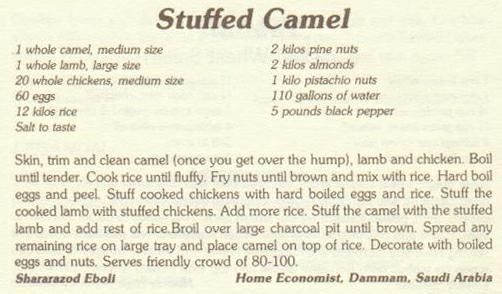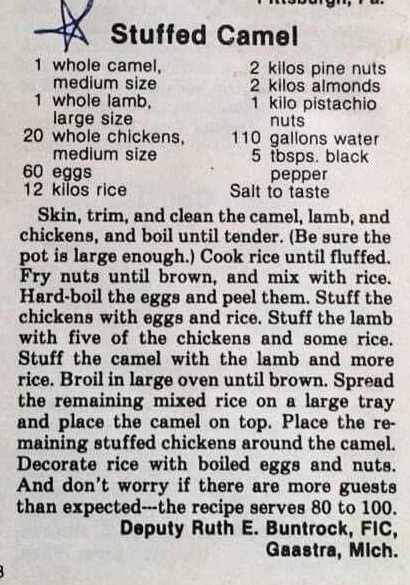We received in the following inquiry regarding a purported international cookbook receipt for stuffed camel from a reader back in 2004:
Could you please tell me if this is real or folklore? I've seen it posted in several areas and just lost a bet that you would have it covered already.
In a cookbook called International Cuisine, presented by California Home Economics Teachers, 1983 (ISBN 0-89626-051-8), you will find:
Stuffed Camel
1 whole camel, medium size
1 whole lamb, large size
20 whole chickens, medium size
60 eggs
12 kilos rice
2 kilos pine nuts
2 kilos almonds
1 kilo pistachio nuts
110 gallons water
5 pounds black pepper
Salt to tasteSkin, trim and clean camel (once you get over the hump), lamb and chicken. Boil until tender. Cook rice until fluffy. Fry nuts until brown and mix with rice. Hard boil eggs and peel. Stuff cooked chickens with hard boiled eggs and rice. Stuff the cooked lamb with stuffed chickens. Add more rice. Stuff the camel with the stuffed lamb and add rest of rice. Broil over large charcoal pit until brown. Spread any remaining rice on large tray and place camel on top of rice. Decorate with boiled eggs and nuts. Serves friendly crowd of 80-100.
Shararazod Eboli Home Economist, Dammam, Saudi Arabia
We're sorry our correspondent lost a friendly wager on our account, but her message was the first time we'd come across this item.
A slight stumbling block was created by the fact that the ISBN provided was apparently assigned to more than one book, leaving some people (including ourselves) quite puzzled about we were so earnestly searching for a copy of Recipe Treasury: 301 Kitchen-Tested Favorites. Nonetheless, it didn't take long to track down a copy of the correct book (International Cuisine) and verify that the "Stuffed Camel" recipe cited above did indeed appear on the Saudi Arabia page within the Middle East section of the book:

Okay, so we verified that the recipe appears in a cookbook, but that doesn't answer the question of whether it's real or just a joke.
Even for a dish as exotic as stuffed camel, this recipe looks like something designed for the purpose of pulling legs rather than creating meals. Consider the poor cooks who have to skin, trim, and clean a whole camel (medium size) as well as 20 whole chickens and a large lamb, boil all 22 of these animals (until tender), then stuff the chickens with hard-boiled eggs and rice, stuff the lamb with 20(!) stuffed chickens, and stuff the camel with the superstuffed lamb, finally broiling the whole thing over a large charcoal pit (until brown).
Inside jokes abound in this recipe. The preparer is instructed to clean the camel "once you get over the hump." The list of ingredients helpfully includes "110 gallons of water," presumably because that's how much liquid it takes to boil a camel. Take a look at a 110-gallon aquarium and imagine trying to boil a whole camel in that small an amount of water. Indeed, try to imagine having a pot large enough in which to boil a camel, or ponder where you might conceivably buy one:

While all the other ingredients in the recipe are quantified, the amount of salt needed for this enormous repast is simply left "to taste."
Other iterations of this recipe perpetuate the same forms of humor, instructing the hapless cook to "skin, trim, clean, and boil" a whole camel, 20 whole chickens, and a whole lamb, with the helpful reminder to "Be sure the pot is large enough." Presumably, though, no chef needs to be alerted to have on hand a tray large enough to hold a stuffed whole camel surrounded by fifteen whole chickens:

The Guinness Book of World Records included a similar dish in their listings, but they merely cited the recipe without documenting any instance of someone's actually having used it:
The largest item on any menu in the world is roasted camel, prepared occasionally for Bedouin wedding feasts. Cooked eggs are stuffed into fish, the fish stuffed into cooked chickens, the chickens stuffed into a roasted sheep's carcass and the sheep stuffed into a whole camel.
In the introduction to his book The Fearless Diner, globe-hopping gourmet Richard Sterling described finally encountering someone who claimed to have cooked up a banquet of roast camel:
I was on my way to circumnavigate the globe a few years ago, to literally eat my way around the world. It was my gustatory goal for that year. I stopped in Bangkok to visit Sven Krause, executive chef of the Celadon restaurant in the Beaufort Sukhothai Hotel. He took me into the inner sanctum of the Celadon's kitchen, where he dared me any half-dozen dishes just to prove he could make them and make them quickly. It was no contest. Within minutes he presented me with a Thai feast. As I munched each delectable dish, I asked him to tell me his most unusual cooking experience.
"You won't believe it," he said.
"Try me," I said, feeling a tug of intuition about the tale he was going to relate.
"I was working in Saudi Arabia," he continued. "There was a wedding of some sheik or other. And you won't believe what they wanted me to cook."
I knew in my gut, in my gastronomic soul, that what I had long hoped was true. That it wasn't just some wild traveler's tale designed to stir the imagination and not the pot. The ultimate cookout was a reality. The only thing that could possibly be greater would be to spit-roast a giant squid. My wildest culinary dream could come true. Sven, Allah bless him and may his tribe increase, had done it.
"I tell you no lie," he went on, sipping a cold one. "They wanted camel. I roasted a whole camel on a spit."
"Yes!" I cried. "Tell me everything." And he did. He told me how he stuffed the camel with six sheep, stuffed the sheep with chickens, and the chickens with fish. He told me how it took 24 hours to cook, and that he served it on a silver platter in the shape of a recumbent camel. He related how the tribesmen who were the sheik's guests then attacked it with their knives en masse, feasted with their bare hands, and ate the meat down to the ivory.
Although Sterling later wrote of having feasted on camel himself, the preparations he described for that meal were nothing like the infamously extravagant recipe of interest but merely various dishes prepared using camel meat:
The whole village turned out, and it was said to be the most magnificent feast that anyone had ever attended. Amdi's mother supervised the preparation and sent [the camel] to us in many guises: roasted, stewed, grilled, braised with vegetables, made into soup. I stood by with a notebook, as Mother directed her daughters and daughters-in-law, writing down the recipes. And the anticipation! It was as savory as the meal itself. The Ultimate Cookout was happening before me, in the shadow of the Sphinx, and in my honor no less.
Actual (non-camel) dishes do exist wherein different types of meat are stuffed into each other. The turducken is one such culinary adventure: a chicken stuffed into a duck stuffed into a turkey, all boneless. As for stuffed camel, it seems to be less a real dish than a tall tale which Middle Easterners delight in foisting off on gullible tourists.
We'll close by noting the similarity between the stuffed camel recipe and a joke about how to make elephant stew:
Elephant Stew
Ingredients:
1 elephant
10 warthogs
100 kilograms tomatoes
1000 kilograms potatoes
2 bags onions
100 kilograms salt
1 wheelbarrow onions (heaped)
10 liters vinegar
20 liters chutney
4 guineafowlPreparation:
Hunt the elephant, warthog and guineafowl. Hang guineafowl to ripen. Cut elephant into edible chunks (will take about a month). Boil the warthog with other ingredients (except guineafowl) till nice and juicy. Now boil elephant chunks over high flames till tender (will take about 4 weeks) and add everything together. Boil for another 5 to 7 days.
Produces about 3,500 helpings.
Note: If the above isn't enough, add the guineafowl as well.

